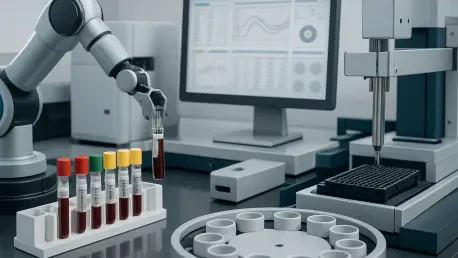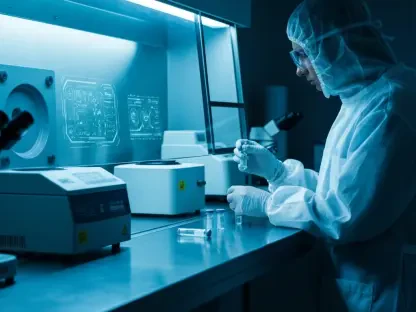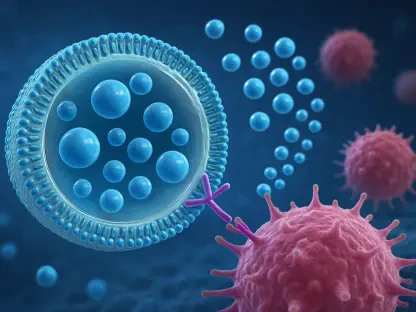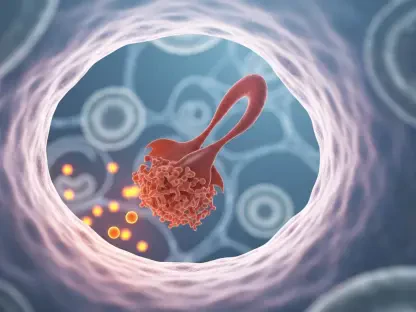In the high-stakes world of biopharmaceuticals, where developing a single drug can cost upwards of $2.7 billion, inefficiencies in clinical bioanalysis pose a significant threat to timelines and budgets, often delaying critical decisions by weeks or even months. Traditional manual methods, frequently plagued by human error and slow data processing, risk entire programs, but automation in clinical bioanalysis emerges as a transformative force, promising to streamline processes, enhance precision, and accelerate the journey from lab to market. This review delves into the technologies driving this shift, evaluating their capabilities and real-world impact on an industry under pressure to deliver therapies faster and more reliably.
Core Technologies Powering the Transformation
Laboratory Execution Systems (LES)
At the heart of bioanalysis automation lie Laboratory Execution Systems, sophisticated platforms that integrate equipment control, protocol enforcement, and regulatory compliance into seamless, cloud-based workflows. These systems ensure that every step, from sample handling to data logging, adheres to strict guidelines such as Code of Federal Regulations 21 Part 11. By automating tasks like barcoding and environmental condition tracking, LES minimizes deviations and bolsters data integrity, a crucial factor in maintaining trust in results.
Beyond operational control, LES introduces efficiency through innovative quality assurance models like “review by exception.” This approach allows teams to focus only on anomalies rather than scrutinizing every dataset, slashing review times significantly. The scalability of cloud integration further enables real-time collaboration across global teams, ensuring that data is accessible and secure, even in high-volume testing environments.
High-Speed Analytical Techniques
Complementing LES are cutting-edge analytical tools like high-pressure liquid chromatography–mass spectrometry (LC–MS), which have redefined speed in bioanalysis. Capable of reducing run times to under two minutes per sample—compared to older methods that took up to 15 minutes—these techniques enable rapid processing of large batches. Such efficiency is vital for supporting adaptive study designs where quick data turnaround can influence dosing adjustments or trial directions.
The precision of these high-speed tools also stands out, with timing variances tracked to milliseconds, ensuring consistency in results. This combination of speed and accuracy empowers researchers to make informed decisions swiftly, mitigating risks of delays in toxicology reporting or clinical milestones. As testing demands grow, these technologies prove indispensable for maintaining pace without sacrificing quality.
Industry Adoption and Emerging Trends
Automation’s footprint in clinical bioanalysis continues to expand, with cloud-based data management systems gaining traction for their ability to centralize information and enable real-time analytics. These platforms facilitate instant access to results, allowing stakeholders to monitor progress and address issues as they arise. The shift toward digital ecosystems reflects a broader industry push for transparency and agility in drug development processes.
A notable trend shaping the landscape is the integration of artificial intelligence in bioanalytical pipelines. AI-driven tools are beginning to predict outcomes, optimize protocols, and handle complex datasets, paving the way for smarter, more efficient workflows. With around 10,000 molecules currently in AI-supported development pipelines, the demand for high-throughput, scalable automation platforms is undeniable, signaling a future where manual methods may become obsolete.
Additionally, the industry is witnessing a move toward value-based pricing models, replacing outdated cost-plus structures that often hid unexpected fees. This economic shift, paired with technological advancements, aims to align costs with tangible outcomes, addressing long-standing frustrations in outsourced bioanalysis. Together, these trends underscore a commitment to modernization across the sector.
Real-World Impact on Drug Development
The practical applications of automation in clinical bioanalysis are already evident in accelerated drug development timelines. For instance, automated systems have proven instrumental in delivering toxicology data faster, preventing setbacks that could delay manufacturing or clinical trial slots by months. Such speed ensures that programs stay on track, a critical advantage in a competitive market.
Globally, automation supports the massive volume of clinical testing required to bring therapies to diverse populations. By ensuring compliance with stringent regulatory standards, these technologies enable seamless operations across borders, meeting the needs of multinational trials. The ability to handle hundreds of millions of tests efficiently positions automation as a cornerstone of operational success.
Moreover, the enhanced precision and reduced error rates offered by automated platforms translate to higher confidence in data, which is paramount for regulatory submissions. This reliability not only streamlines approvals but also builds a foundation for trust among stakeholders, ultimately benefiting patients awaiting new treatments.
Challenges Hindering Widespread Adoption
Despite its promise, integrating automation into existing bioanalysis frameworks presents technical hurdles. Compatibility issues with legacy systems often complicate deployment, requiring significant investment in infrastructure upgrades. Additionally, ensuring data security within cloud environments remains a concern, as breaches could undermine the integrity of sensitive information.
Regulatory challenges also loom large, with compliance to complex standards demanding rigorous validation of automated processes. Resistance to change within the industry further slows adoption, as traditional practices are deeply ingrained in many organizations. Overcoming this inertia necessitates cultural shifts alongside technological solutions.
Efforts to address these barriers are underway, with industry collaborations focusing on standardizing integration protocols and enhancing cybersecurity measures. Refinements in automation technology, coupled with educational initiatives to highlight benefits, aim to ease the transition, ensuring that hurdles do not derail progress toward a more efficient future.
Future Potential and Industry Outlook
Looking ahead, the trajectory of clinical bioanalysis automation appears poised for significant leaps, particularly with deeper AI integration. Predictive analytics and machine learning could further reduce data turnaround times, potentially transforming how studies are designed and executed over the next few years, from 2025 to 2027. Such advancements promise to make bioanalysis not just faster but also more intuitive.
The long-term vision includes a fully industrialized framework for bioanalysis, where automation handles vast global testing needs with unmatched scalability. This shift could drastically shorten the time it takes to deliver therapies to patients, addressing urgent medical demands worldwide. Economic reforms, like transparent pricing, will likely support this industrialization by aligning financial incentives with technological capabilities.
Ultimately, the evolution of automation in this field points to a paradigm where precision, speed, and volume coexist without compromise. As barriers are dismantled, the biopharmaceutical sector stands to gain a competitive edge, redefining how innovation reaches those in need.
Final Thoughts
Reflecting on the journey of clinical bioanalysis automation, it becomes clear that these technologies have already reshaped critical aspects of drug development with remarkable speed and accuracy. The strides made in Laboratory Execution Systems and high-speed analytical methods demonstrate a capacity to overcome longstanding inefficiencies. Moving forward, stakeholders should prioritize strategic investments in integration solutions to bridge gaps with legacy systems, while fostering industry-wide partnerships to tackle regulatory and security challenges. Emphasizing training programs to shift mindsets away from manual reliance will also prove vital. By committing to these actionable steps, the biopharmaceutical field can fully harness automation’s potential, ensuring that life-changing therapies reach patients with unprecedented efficiency.









